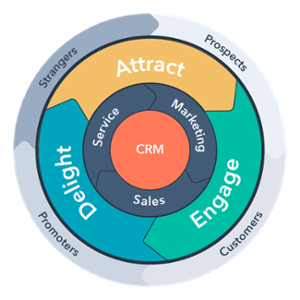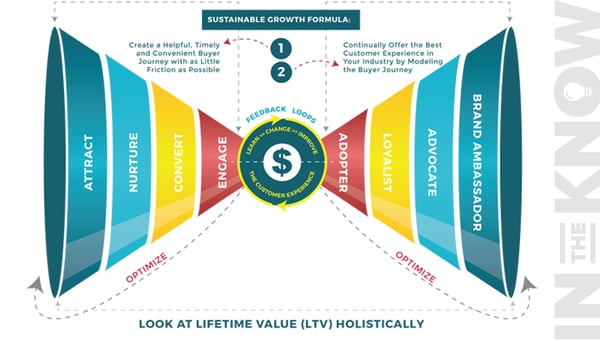In 2018, HubSpot made a surprising announcement.
They were ditching the “sales funnel” and transitioning to a “flywheel,” which as they explained, was a more modern approach to looking at your visitors, leads, and customers. There are many advantages to the flywheel, HubSpot says, such as less pressure on acquiring new leads and a more balanced focus throughout the various sales stages.
However, when you look closer at the sales funnel versus flywheel, you might notice that a lot of the benefits have little to do with the structure at all. Focusing on relationships, being strategic at every stage of the buyer journey, and aligning your sales and marketing team isn’t exactly revelatory information.
That’s why when it comes to the sales pipeline funnel versus flywheel model, I’m going to say what everyone is thinking.
There isn’t much difference at all.
The Sales Pipeline Funnel Versus Flywheel
The HubSpot Flywheel is something a lot of marketers see as a new, creative way to structure the ye olde sales funnel. The idea with the flywheel is that you don’t just abandon your customers when they drop from the funnel, rather, you transition them to brand advocacy.
You add energy to the flywheel, it gains traction, builds up momentum, etc. You pay more attention to every stage of the journey and work closely with your team to strengthen customer relationships. You get the gist. The flywheel is all the rage, and a lot of marketers think it’s time to switch it up and ditch the funnel for good.
But here’s the thing.
The flywheel is pretty much the same thing as what we call the double funnel, which a lot of marketing and sales teams are already doing. Basically, with the double funnel, when customers drop out of Funnel #1, they move to Funnel #2, which focuses on making them brand advocates.
The choice to switch to the flywheel, rather than being the next level of marketing, is more of an opportunity for HubSpot to introduce something fresh, and coin a new term since the phrase “inbound marketing” is losing steam.
(Plus, the sales funnel is a term owned by Russell Brunson from Clickfunnels.)
It’s Marketing 101 - taking an existing metaphor, putting a new spin on it, and calling it something new.
That’s why you don’t need to throw your funnel out the window just because HubSpot says so. Instead, you need to refine your funnel and make sure that you’ve got the fundamentals and best practices down.
Here’s how you can make sure you’ve got a great sales pipeline setup, funnel or flywheel.
1. Review Your Overall Business Goals/Objectives
Funnel or flywheel, you need to make sure you’ve got the right goals in place from the start. That means you need (SMART) specific, measurable, achievable, realistic, and timely goals that keep you moving forward. Having these realistic goals are critical in measuring performance, finding gaps in process and talent, and gauging the effectiveness of your marketing and sales initiatives.
Setting the right goals can be tricky. You don’t want to be too aggressive and make your goals impossible to reach, but you still want to challenge your team. However, if you select goals that are way too easy, no one will feel energized or excited when they meet them. That’s why you want to aim for somewhere in the middle.
Even when you have these types of goals in place, it’s good to check every now and again to ensure that they’re still the ones you should be focusing on.
If you need to set new goals, create a baseline first. Your baseline is where you are now, regarding leads, conversions, visits, etc. I would take your performance from over the past six months and calculate an average for new customers, organic visits, conversions from the website, etc. Then, you can anticipate how you want to grow those numbers month by month.
If you’re struggling to meet very specific goals, such as increasing organic traffic or leads, check out this more in-depth piece about setting meaningful marketing goals and objectives.
2. Find Which Sales Pipeline Stages Fit Your Organization
One of the biggest myths in marketing is that every company will have an identical sales pipeline. But it’s not a one-size-fits all type of situation. In some instances, your sales pipeline will differ. When going through your pipeline, the better question to ask is how each sales pipeline stage fits your industry, and how you need to leverage each stage to hit your goals.
Here's an overview about the first funnel stages and how they change to can fit different organizations.
Awareness
If your company is brand new, the awareness stage is going to be critical for you. No one knows who you are yet. You will need to invest more time and resources than an established company during the awareness stage, creating high-quality content that helps attract prospects for the first time. You will need to have a solid understanding of the questions those visitors are asking, and the type of content they’re looking for online.
However, it takes time for a newer organization to produce and start generating traffic for TOFU content. Blog posts, videos, etc., take time to circulate and grow, like seeds in a garden. Because of that, the awareness stage can be much longer. It relies on your current growth and how well people know you already.
Interest
At the interest stage, you want your customer to know that there’s a solution to their problem and capture their - you guessed it - interest. When the customer is through the awareness stage (regardless of how long it was), you need to present them with lead magnets and educational material.
When you're developing content at this stage, you want to to identify potential problems, frustrations, and challenges that your ideal customer is experiencing.
Consideration
At the consideration stage, the customer is still trying to decide whether or not they need to move forward. For this stage, you need to be very aware of how your target persona makes purchasing decisions. Do they need to ask a stakeholder to sign a check? Will they need to get approval from someone?
When you’re in an industry where the consideration stage requires a lot of hoops to jump through for your customer, you want to prepare them for that battle. For example, you can provide pricing sheets, content that debunks cheaper or alternative solutions or fact sheets they can forward to stakeholders.
If you’re in an industry and your product or service is on the pricier side, or if you’re going up against a tough competitor, try to anticipate the questions and challenges your customer will face when trying to buy from you.
Decision
In industries with faster sales cycles, the decision stage is critical. Since the customer is moving faster through those previous stages, there’s not as much trust established. The potential customer hasn’t engaged with content assets such as case studies and video testimonials to convince them you’re the right choice. There also isn’t much emotional investment or time spent that secures you as their selection.
In this case, you need to work with their momentum and streamline this part of their journey. You want it to be as pain-free as possible to become a customer.
If you can approach each stage with this fresh perspective, you can create a buyer journey that makes sense to your lead. You can make it easy and appealing for them to become a customer. If you copy what everyone else does, however, you’ll create a rigid process that doesn’t make your target customer feel at ease.
3. Define Your Leads
When it comes to defining a marketing qualified lead (MQL) and a sales qualified lead (SQL), you need to focus on what makes sense for your organization. You don’t want to use a paint-by-numbers template to set these definitions. There’s only so much that articles and YouTube videos can guide you in determining what makes a customer a fit for your company.
Instead, go to your marketing and sales teams and discuss each of these definitions. You want everyone to be on the same page about how one becomes an MQL, and what steps they need to go through. The same for an SQL. In an ideal scenario, how would the process of becoming a lead, becoming an MQL, and transitioning to an SQL look like for your company?
If you need more context about defining leads, check out how customer journey mapping can help.
4. Set Up Lead Generation and Qualifying Tactics
To move your customer through the buyer journey, you need to have an intimate understanding of the process. For each funnel stage, you need to be certain of the conversion points, content, and website pages they engage with. It’s critical to walk in their shoes to not only anticipate roadblocks but also to set up the best lead generation and lead qualifying tactics.
At every stage, you want to educate and connect with your lead, but you also need tactics in place to help you learn about them. Features like progressive profiling and smart forms can help with this, collecting more information about leads while asking for less information upfront.
To avoid being redundant or speaking to a potential customer in a way that does not match their current stage, you can also use smart content. Smart content can attract qualified leads by presenting them with more effective messaging targeted precisely for where they are in the buyer journey.
All of this helps you attract better leads and qualify them as they move through the website journey.
now, fill up Your Sales Pipeline Funnel (Or Flywheel)
Of course, without regular, incoming website traffic, you're going to have difficulty filling your sales pipeline at all. Once you have the stages of your pipeline nailed down and understand how you need to engage your customer at every point, your focus should switch to bringing in better website traffic.
In lieu of paid initiatives, which requires a continuous stream
of revenue, we focus on building up organic traffic. With the right strategy and execution, you can keep organic traffic compounding month over month. An ongoing investment in building organic traffic will keep your flywheel spinning (or your funnel overflowing.)
To learn more about increasing your organic traffic, check out our guide, The Ultimate Guide To Increasing Organic Website Traffic.






